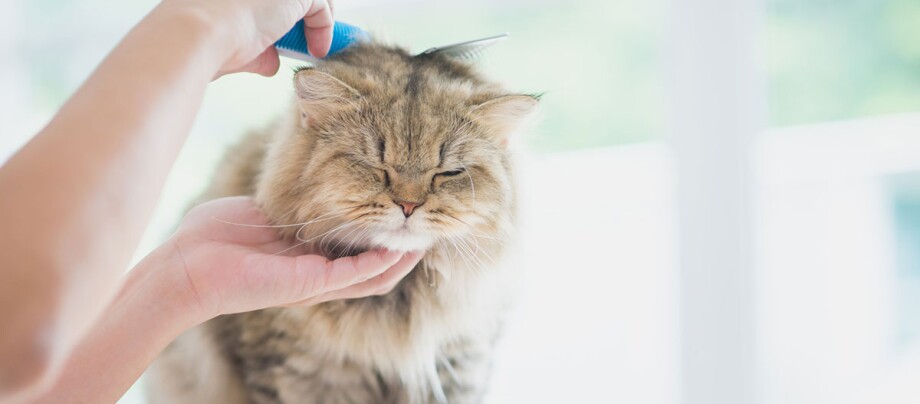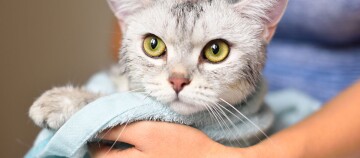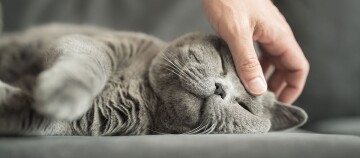Cat Grooming - Easily Free Your Home and Clothes of Cat Hair
14.11.2022 - Reading time: 4 minutes

Whether a fluffy Angora cat or a sleek Siamese cat, the coat must always be groomed. Generally, the cat does this itself. It spends a large part of the day grooming its fur with tongue and paws. For cat breeds with very long fur you, as the owner, will have to assist. But breeds with a short coat also enjoy massage and grooming. Coat care also has other tangible benefits: parasites find a groomed coat too much trouble, and you recognise skin lesions or inflammations at an early stage already.
How is a cat’s coat structured?
Did you know? The skin is a cat’s largest bodily organ and can account for up to 24% of its weight. The skin serves to protect the organism and shield against environmental influences and germs. This amazing organ performs impressively to fulfil this duty. Dead hairs are shed daily and new ones are constantly regenerated – the notorious cat hair. Owners of a light-furred cat who like to wear dark clothes know what this can mean. A cat’s coat consists of a dense undercoat and the longer topcoat, whereby, depending on breed, there can be big differences between the amount and density of the undercoat and length and texture of the topcoat. Twice a year shedding is particularly heavy: with disappearing daylight and rising temperatures your cat grows in its winter coat, and sheds it again during spring. Many cats cannot keep up with the grooming during these times and really appreciate it when their human steps in for hairdressing duties.
How do I care for a cat’s coat?
Your most important accessories for cat grooming are a comb and brush. For cats with a very short coat and little undercoat, you can use a baby hairbrush. The specialty shops will also offer various brushes and fur combs with various bristles. Brushes with fine bristles that are not too hard are particularly suitable for fine work and removing felt from your cat’s coat. Use your fingers to carefully untangle knots in the coat with your fingers. Never comb them out forcibly.
It is best to get the cat used to the brush by playing with it as a kitten, so that it recognises and enjoys the treatment. Schedule at least 15 minutes a day for grooming. Make sure the atmosphere is relaxed. Sit the cat on a table or your lap and always brush and comb in a line from the ears to the tail. Never comb the tail itself, just brush it. Carefully groom the cat’s belly by reaching around from the cat’s body from above.
By the way: The more care you demonstrate in combing your cat, the less loose hair will end up on the carpet and furniture. At particularly hairy times, cover the cat’s favourite places with blankets, that the fur fluff can get caught in. You can save yourself a lot of work by using a lint roller and carefully brushing and washing your cat. You can also provide support the cat’s coat health from the inside.
Pay more attention to what you put in the cat's bowl:
- Special feed or feed supplements, for example pastes with Omega 3 and 6 fatty acids when moulting assist with coat health.
- Vitamins, copper and zinc are also important for maintaining healthy skin. Speciality shops offer the appropriate supplements. Caution: do not overdose with vitamins. Pay attention to what they are already getting through regular feeding.
- Good source of protein:Seasonally, up to one third of the protein provided in the feed is for the skin.
You should bathe your cat in exceptional cases only: only using prescribed medical shampoos or emergency help in case of a mishap with sticky substances justifies a careful lukewarm shower.
What should be considered for coat care with long haired cats?
The fur of long-haired cats has become uncomfortably long for self-grooming due to deliberate breeding to create an opulent appearance. For Angora and Persian cat breeds, for example,intensive daily grooming by their humans is essential as the animals cannot cope with the abundance of their fur on their own. Combs with long tines and soft wire brushes are best for grooming a long-haired cat. Carefully cut out matted knots that with the best will in the world cannot be untangled.
What can I do about cat hairballs?
Hairballs forming in the cat’s stomach as part of grooming: hair is caught on the cat’s tongue and is swallowed. As indigestible foreign bodies, they accumulate in the stomach and are regurgitated and choked out in compressed form. A natural instinct helps make the natural process more pleasant. Your cat will actually look for plant fibres that strengthen the consistency of the hairball and make it more easy to reguritate. This is the reason why cats occasionally eat grass. Be sure to offer your indoor cat some cat grass to satisfy this need and prevent the cat from eating houseplants. Seed mixtures are available in pet and garden shops. Alternatively, or even better, you should offer the cat dry food with fibre and malt paste.


